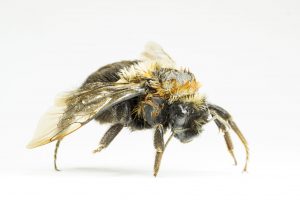The common eastern bumble bee, Bombus impatiens, is one of the most frequently found bumble bees across the eastern half of North America. Their native range extends north-south from Ontario to Florida, and east-west from Maine to the Dakotas.
In Florida, it is one of five species of social bumble bees native to the state. One of the unique characteristics of the common eastern bumble bee is that it has been commercialized and sold for crop pollination, being one of only a few species of domesticated bees outside of honey bees.
The common eastern bumble bee shares the same identifying features of other bumble bees such as a hairy robust body and a pollen basket on the hind legs where large spheres of densely packed pollen can be carried.
It can be distinguished from the other bumble bee species in Florida by the single stripe of yellow hairs on the first abdominal segment, with the rest of the abdomen covered in black hairs. Other bumble bees in Florida have yellow hairs on more than one abdominal segment, with some having the majority of the abdomen covered in yellow hairs.

Most bumble bee species are social and produce annual, or yearly, colonies, the exception to this being the parasitic bumble bees. In the non-parasitic or social bumble bees, such as the common eastern bumble bee, new queens begin their colonies in the spring and start to produce workers, which subsequently take over the duties of collecting pollen and nectar.
In the latter portion of the season, the colony produces new queens and males, which leave the colony to mate, after which time the males die. All of the workers along with the founding queen will also die at the end of the season before the overwintering period.
This leaves only the new queens to overwinter and begin the cycle again in the spring. Because these are annual colonies, they never get as large as perennial honey bee colonies, typically having only a few hundred workers at their peak.
The common eastern bumble bee, like many bumble bees, nests in shallow belowground cavities such as abandoned rodents’ nests. They are generalists, meaning they will visit a variety of plants, and their foraging period extends from early spring through late fall. This generalist foraging behavior and long foraging period make them good pollinators for a variety of plants.
Due to their pollinating potential, they have been commercialized and are available to purchase from a few international companies. They are mostly used for pollinating crops in greenhouses, such as tomatoes, but have become increasingly common for the pollination of fruits and vegetables in the field including blueberries, cranberries, apples, strawberries, and almonds. Their value for crop pollination makes them one of the most economically important bees in the world!
Read more about bumble bees here: http://entnemdept.ufl.edu/creatures/misc/bees/bumble_bees.htm
 1
1
